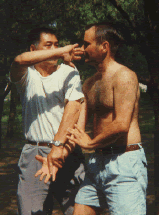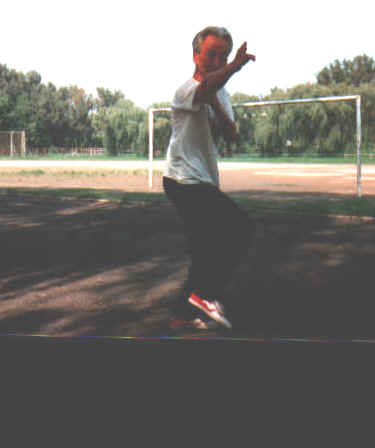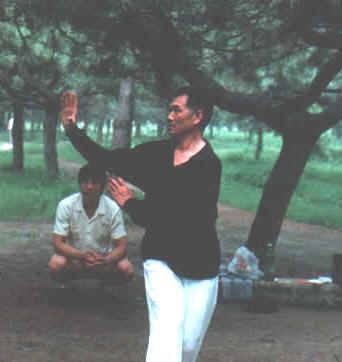|
My
teachers.Some notes of color...
Having frequented for a long time many Chinese teachers, the anecdotes would not miss me. I will give here some brief
story for understanding better their personality and their background.
All the Chinese world of the Martial Arts is a world of jealousy. I have been
near many of them, generally having intention to integrate what I already knew with
something new. Nothing to do ! My first teacher was (a part the parenthesis with
Li Ziming) Liu Jingru. When I introduced me to a new teacher and I made him this name as a guarantee, as to say that I had already had a good teacher, the reaction was almost always the same one with small variations,: ironic looks, giggles, brief comments to make
me understand that I had been with a laughable teacher. I stayed badly there , until I have not understood (after a lot of of these
experiences) that this is indeed the rule: all speak badly of everybody!
There was not this only; inevitably I had to start afresh everything! This is also logical but
surely enough it was not pleasant. But we see more in detail what thr teachers
were.
In the beginning I compared, in my mind, two schools, the Li Ziming's and the
Liu Jingru's. What is that makes to prefer a school to another? Would it
be the fame, would not the choice even be
done. Li Ziming was considered then the maximum authority of the Chinese baguazhang representing one of the few teachers of the
third/fourth generation,; Liu was almost then a new grass and belonged to the fifth generation. There was not
clash in my mind: the Bagua of Liu was fluid, serpentine and spectacular; that of
Li was perhaps more at main point but less "appealing". Therefore I frequented both, the first year
(Liu in the morning and Li in the afternoon) but when it happened, the following years, to practise again, the choice was made soon: Liu Jingru!


Little picture:Liu Jingru performs the Cheng school Baguazhang ;
great picture: Zhu Baozhen
of the Yin Fu school performing
Chongzhang
Liu Jingru was a great deal a beautiful Chinese, agile, strong and in the full one of
his strengths. His Baguazhang is, to say, in the area of Beijing and in the school of Cheng Tinghua, the most beautiful that
I know. Although now he is almost toward the seventy, Liu still shows a discreet agility and
strenght. What lacked him they were the applications: Some of these were laughable and this is also
the same for other teachers. How do we explain this? You easily explain it
with the Confucian ethics that still now strongly influences the Chinese
world, perhaps without not even they realize it. In this ethics the superior
one is really such and there was once a sacred fear in his respects. If you stuck to the school of a teacher you had to respect every choice of his without
discussion. This was confirmed me by Yu Yongxi, my principal teacher of Xingyi, that one day explained me as the
Kungfu training happened in China. A teacher taught "formally" a technique simply practising
it once by himself. You, as a student, had to absolutely be careful and to repeat better
you were able. Exceptionally the teacher would have repeated it to you a second time and, in rare cases
, a third time. After the first time the student was left to himself to repeat better the technique as
he was able, at times for periods also a great deal long. Li Ziming for instance told
me that he had practised for just three years only the first change of Bagua, Danhuan
zhang. This explains how it happened that every student of a same teacher, when
many years after he started in turn to teach, he practised the same technique in different way from another student: simply he remembered
it in that way and he/she had assimilated it this way.If he had learned it and practiced in relative isolation
(as often it was the case)the technique was such. If he/she had had the fortune to practise together to others
(that it was not always the case) then perhaps the technique, comparing itself with that of the
others, would have reached a standard that was that middle of the school.
But how did it happen that the applications were laughable, as I have said more above?
Well, the teachers rarely practised them. There were teachers that didn't even accept to be touched by their students. An example of these was Yip Man of the Wingchun, even if there
are pictures that show him while doing something wit somebody else. However this was
his rule!
Being afraid of the teacher's charisma , the students didn't dare to ask the teacher
what meaning had that single movement! . Simply they repeated it, trying to show
themselves in their mind what could be the usage. Only perhaps the first generation of students of Dong Haichuan (and that is Yin Fu, Cheng Tinghua and
others) had been introduced to the usage of the Baguazhang as real martial technique. But the following generation already had partly lost this knowledge,
so true that Liu Dekuan felt himself in duty to create more martial linear forms
, strongly influenced by the Xingyiquan, to create a "Dictionary" of techniques whose sense was clear. The use of the Bagua on the circle had evidently lost already in clarity.
I don't doubt that a lot of techniques, to that time, were still clear and that others
were added according to the experience and of the predispositions of the single teachers
. The fact stays that the meaning of the techniques going around the circle
gradually lost of clarity and of effectiveness. The Bagua was formally circular but in the
real practice linear. Only the Yin Fu school remained (and also that only partly) relatively in isolation and preserving lines of effectiveness.
Of the Yin Fu school, apart Liu Jingru that has only shortly practised
it, I have known two exponents of point, Xie Peiqi and Zhu Baozhen. A third exponent with which I have practised in Italy is Zhang Dugan but its Bagua it is
flowery so much to resemble more to the Cheng school that to the Yin school
.
The most archaic bagua that I have seen is Xie Peiqi's Bagua. His kungfu preserves
really archaic features. Already the man that represents it is a symbol of this archaism. Xie Peiqi is ugly indeed (to the time when I knew
him he was also toothless and it was then only starting to frequent a dentist, perhaps for a denture). This is not impoliteness in
hisr comparisons. We say that it could be the middle verification of a westerner. However, what a power! Low of stature as
he was, he regularly made me fly to beat against the angle of his room (on whose floor was traced the
Eight Diagrams circle ). Also, he laughed at Liu Jingru and I did practise with him, that summer (1993? 1994? ) the
Dragon Form (Longxing). He has a system for which he teaches a determined animal to every student. To few,
he teaches everything! Recently his successor, that is the student to which he wanted to hand down everything, was dead in an accident and so now
he wanted to open more his art in the fear that it was lost soon. Recently
he has published a series of video on it.
What struck me, practising with Xie, they were the similarities with the Fu Zhensong
school that, at that time I was still studying in Guangzhou, (Canton). This confirmed a news according to which Fu Zhensong would have studied with
Ma Gui, the most known student of Yin Fu.
This brings me to speak of the two characters of the Fu school with which
I have studied, two brothers, Fu Meilan (my principal teacher) and Fu Wenlong: although also their applications were some limited ones, they had an unbelievable power. To fight against Fu Wenlong, should not be particularly a pleasant experience. Its hits of
finger-points seemed played with a shovel, given their penetrating power. Under the aspect of the power this school
struck me more than that of Xie Peiqi. This is evident even in their Taiji where the hits are brought with a particular vibration and with a rather hard
(vibrating) fajin. The cyclonic Baguazhang was powerful as any
other form of the school.
The other important teacher for mine "career" was Zhu Baozhen. Its physical structure is different a great deal from that of the others of which I have spoken above. Thin and dry, nevertheless in the applications it also shows perhaps agility and power
in the same way of Liu Jingru. Also he had the tendency to denigrate Liu but this
I felt unfair since it is certain that for a period they have worked together, in the construction of various competition forms that
synthesize the Baguazhang of the principal schools of the capital. In two of the last occasions of training I have learned two of these forms. The first one is the best and it has the name of Zonghe Bagua zhang. In it they are inclusive techniques from the
Liu, Zhu and Sun Zhijun schools, being a mixture of the two schools, Cheng and
Yin.
Unfortunately Liu has not digested the fact to have seen me to a demonstration together with Zhu Baozhen. Although a letter has sent him in which
I reaffirmed my consideration for him and I declared him my first and more important teacher, its resentment it has to be notable because I have not received any answer. Yet I am loyal in
his comparisons and I have also sent him some Italian students. But so the things go
in China (and in the world). It is not easy to accept that a student goes with another teacher, even if this student has learned what was to learn.

Liu Jingru
in: "The Green Dragon feels with the claws"
(Qinglong tanzhao)
Go to the ENGLISH
HOMEPAGE
Go to the HOMEPAGE
|